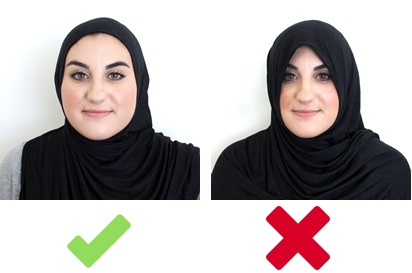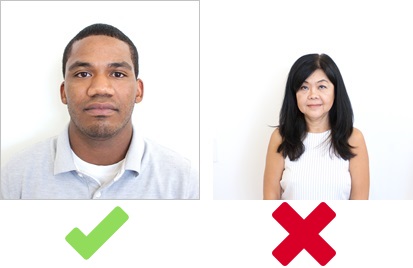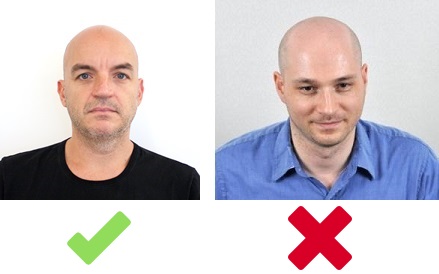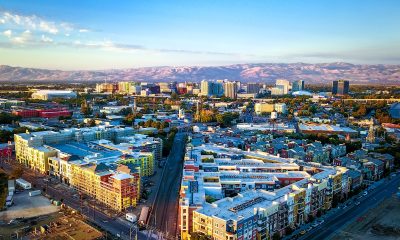Visa
US Visa Photo Requirements, Guidelines And Specifications

This article covers US visa photo requirements and specifications, guidelines to digital photographs and more relevant details.
Depending on the US Embassy from which you apply and the type of US visa, the images required may be physical or digital. Physical images must be printed and mailed as part of the visa application, however digital photos can be uploaded online when you submit your Form DS-160 or Form DS-260.
US Visa Photo Requirements
Your US visa photos must be:
- The US visa photo size should be 2 x 2 inches (51 x 51 mm). The photo should be positioned so that the head is between 1 and 1 3/8 inches (22 mm and 35 mm) or 50% and 69% of the image’s total height from the bottom of your chin to the top of the head.
- In color.
- Taken within the last 6 months.
- With no shadows.
- With a plain white background.
- You must face the camera in the photo.
- Have a neutral expression.
- Have both eyes open.
- You cannot wear a uniform. However, the clothes that they normally wear every day. Religious clothing that the person wears daily is allowed. The head must not be covered, and the hairline has to be visible unless the person wears a headdress for religious purposes. The headdress must not cover the face.
- Without any worn electronic devices. Unless you need a hearing device or something similar.
- You must not wear eyeglasses except for medical reasons. If, for example, the person has had eye surgery lately, they need a statement from a doctor must be provided to justify them. If eyeglasses have to be worn, the frames must not cover the eyes, and there must be no glare or shadows on the face from the glasses.
You can get your high-quality photograph that complies with all the US visa photo requirements at MyBiometricPhotos.
US visa photo do’s and don’t’s
No shadows

Plain white background

Headscarf placed in a certain way

No eyeglasses

Correct head position

Neutral face expression and facing the camera

Digital Photo Requirements
If the US Embassy wants you to submit a digital photo online, it must meet these requirements:
- The photo must be square and 1200×1200 pixels.
- The photo must be in color such as the sRGB color space.
- The format of the photo must be in JPEG.
- The size of the photo must be less or equal to 240 kilobytes (kB).
- If your photo is bigger than that size, it can be compressed to a ratio of less than or equal to a 20:1 ratio.
If you already have a physical photo which meets the physical photo requirements, you can scan it and make it as follows:
- The photo has to be in dimensions of 2×2 inches (51×51 mm).
- The resolution of the scanned photo must be 300 pixels per inch or 12 pixels per millimeter.
Nonimmigrant Visa Photo Requirements
In addition to the standard requirements, there are also requirements for the types of visas. Some of the requirements related to US nonimmigrant visa pictures include:
- Applicants using Form DS-160, might need to submit a digital photo which must meet the digital photo requirements.
- In addition to the digital photo, you might also have to submit 1 physical photo as per their requirements
Immigrant Visa Photo Requirements
For those who are applying for a US immigrant visa to permanently stay in the US, you must submit two physical photos in photo quality paper that comply with the standard US visa photo requirements
Diversity Visa Photo Requirements
For those who are entering the Diversity Visa (DV) program or lottery, the photo has to meet these requirements:
- You should upload a digital photo.
- The photo must be in JPEG format.
- The photo must be square and its dimensions must be 600×600 pixels.
- The size of the photo must be 240 kilobytes (kB).
If you scan an existing photo, it must meet these requirements:
- The resolution of the photo must be 300 pixels per inch (12 pixels per millimeter).
If you get selected for the Diversity Visa Program, you should bring more photos that comply with the photo requirements for US visa.
Where to Take US visa Photos?
It’s hard to meet all the US visa photo requirements alone. That’s why it’s best to use a professional photographer to submit your images to the US Embassy.
Many professional services will take and deliver you digital and physical images that meet the standards. Though more expensive than self-portraits, the Embassy is more likely to approve them.
However, the US Embassy may reject low-quality images and require resubmission. This delays visa processing. Thus, professional stores are the greatest place to submit images.
If you take the images yourself, you must use a high-quality camera, meet all standards, and not use computer software to change your appearance except to remove the red-eye effect.
How to Get a US Visa Photo for Your Baby or Toddler?
If you are also seeking for a US visa for your infant or toddler, you must include images of them. Because babies and toddlers do not sit still for lengthy periods of time, you can either attempt to shoot the images yourself or seek expert assistance. The following are the requirements and advice for infant and toddler visa photos:
- The photo must be of the baby or toddler and no one else must be in the picture.
- The baby must have the eyes open for the photo.
- You can lay the baby down on a white sheet and take the photo, but make sure there are no shadows on the baby’s face.
- You can put the baby in a car seat, but cover the car seat with a white sheet to provide a blank background.
What if I Changed my Appearance Significantly in the Last Months?
If your photo is not older than 6 months, but your appearance has changed significantly then you might have to submit a new photo. This would be necessary if you have done the following:
- Went through extensive facial plastic surgery.
- Added or removed piercings or tattoos on your face.
- Gained or lost a significant amount of weight.
- Transitioned to a different gender.
If you coloured your hair or grew a beard, you will not need to submit a new photo. Teenagers will also not be required to submit new images if their look has changed owing to normal growth. They will be allowed as long as you are identifiable in the images. The US Embassy, on the other hand, is the one who decides whether or not your images are acceptable.






















